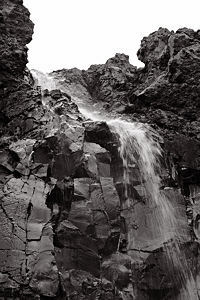 Yesterday I hiked up a mountain for a fabulous view of snow-covered peaks and dark green valleys for many, many miles in all directions. The only photographs I made were of a waterfall on the way up. The surprise is that I made any at all. Despite — or more likely because of — the clichéd nature of the subject, until a year ago I had essentially no waterfall pictures, even of locations I’d visited multiple times, with camera, where I more recently did make photos. Now I have half a dozen or so waterfalls, and I realize it has become a theme. So I want to start looking at them and thinking about them, learning from them.
Yesterday I hiked up a mountain for a fabulous view of snow-covered peaks and dark green valleys for many, many miles in all directions. The only photographs I made were of a waterfall on the way up. The surprise is that I made any at all. Despite — or more likely because of — the clichéd nature of the subject, until a year ago I had essentially no waterfall pictures, even of locations I’d visited multiple times, with camera, where I more recently did make photos. Now I have half a dozen or so waterfalls, and I realize it has become a theme. So I want to start looking at them and thinking about them, learning from them.
My goal is not to categorize these pictures or figure out how to make “better” ones. For me, photography is a visual path to understanding my environment and things I care about in it and why I care about them. It’s not a discovery like finding a gemstone, but more an ongoing process of construction which depends on both the pictures and the thinking. So I don’t expect to reach any conclusions; it’s just exploration.
As part of that personal exploration, it’s very helpful to hear what others think. Most of my waterfalls I have presented here before, but I reproduce them below in a consistent presentation, from old to new. How do you see these images in relation to each other, to other waterfall images, and to images of mine of different subjects? Do you find them distinctive in any way? Have they changed much over the year, or is their continuity more striking? More specifically, in what ways are they different and the same? I do have a few preliminary thoughts, but I’d rather not bias the conversation. What do you see here?
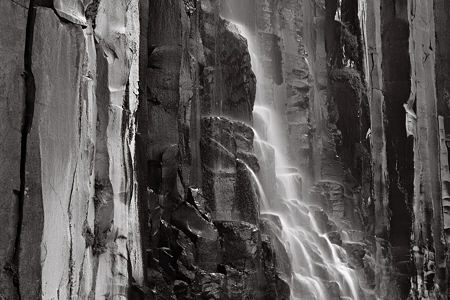
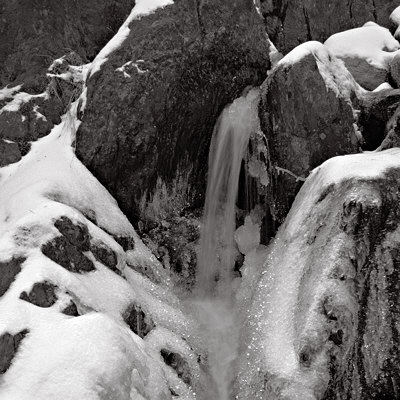
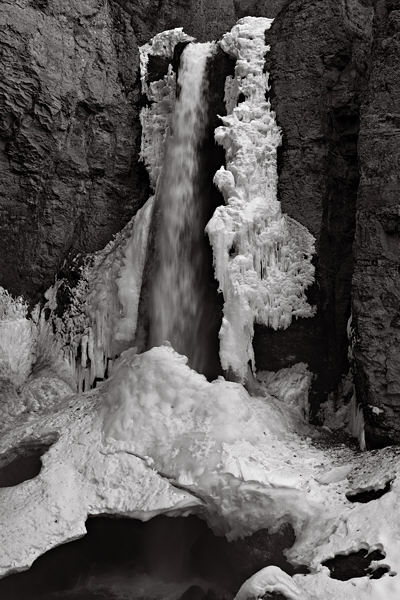
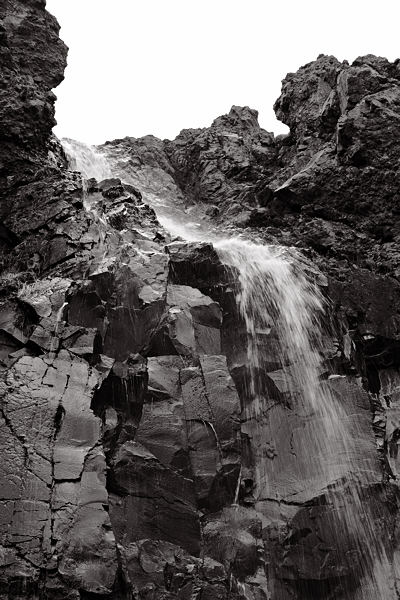

Fascinating pictures – I must say. Your second paragraph about the process of finding out more about your environment through photographs is about the same way I feel as I go about my journey of painting faces…
By the way – the last picture is great, the power of the rocks comes out strongly. I am sure you must have got some water into that camera..
Finding out more about the environment and about ourselves. I can feel the spray..hear the woosh and imagine the roar of the water/wind and rocks. I can also feel the cold and aloneness of the ice. The shadows and tones are intriging yet sometimes feel harsh to me. The different lens and views of the same spots offer a visual variety that appeals.
Sunil,
Interesting that you liked the last best, and your comment is revealing. I do feel it has a stronger three-dimensional presence.
Ginger,
Thanks for your impressions. I realized looking at these that there’s virtually no vegetation in these, which is partly responsible for the harshness, I think — just rock and water/ice. My previous water photos, of streams or lakes, were quite different that way. I guess the starkness was part of what intrigued me.
Actually, the photos are of four different locations, although the geology is not so different. Waterfalls tend to form here running over volcanic rock layers of one sort or another.
In the ice pictures (3+4), I keep seeing creatures. Picture 4 looks like king waterfall, wrapped in an royal hermelin coat.
The last picture is another great study of texture, rough rock on top and smooth where the water polishes it, adding to the second picture that you showed earlier.
For me, photography is a visual path to understanding my environment and things I care about in it and why I care about them. It’s not a discovery like finding a gemstone, but more an ongoing process of construction which depends on both the pictures and the thinking.
Steve,
In the sprit of answering a question with a question (and what’s wrong with that?) I’d like to ask about your views on the “art as…” question. I’ve been thinking a lot about our different interpretations: art as discovery, art as world building. Just last night I came up with the sentence, “art as a journey.” The passage in italics above from your post shows that you are combining these ideas as well. The question is, can you find a metaphor that combines all these facets that we have been discussing?
Steve:
The first and last are, for me, the best. The first image confounds an expectation as the vertical strata invite free-falling water. Instead, it cascades, but does so in a manner consistent with the drape of things. Furthermore, while it can be something of a cliche, the cascade is smoothed out and generalized by what may have been a slow shutter setting. That works nicely in my estimation. And the rocks are variegated.
The second image appears to be a jumble of obsidian, black, shiny and cracked. It looks largely untouched, except for a tentative rivulet. It is a study of contrasts between a frozen liquid and and what may be melted ice. Here’s a good subject for five hundred shots as nothing in it comes across as photo-oppish. Also, you get to get wet. Makes me wonder what a slow shutter setting would do for the dynamics here.
Steve, the thing that strikes me immediately in looking at this sequence of photos is how well they evoke, intentionally or not, the changing seasons and the cyclical nature of things. While other types of images may do so as well (like trees dropping and regenerating leaves, etc.), there’s something about the waterfalls that really captures for me the change in energy we experience in winter. The actual slowing of molecules. It’s as though by seeing this microcosm we experience something much larger.
Karl,
Hmmm, a few incoherent thoughts: I’d say building and journey are somewhat similar metaphors.They may or may not have clear goals or reach endpoints. Perhaps the main difference is that in building you end up with something tangible, whereas with a journey it’s more intangible (in your mind). In both activities you come across surpprises along the way (at least the way I do them). I think of Arthur’s art as world building as referring more to the creation of individual works of art, each implying a world in which it would exist naturally. For example, for Ginger perhaps (and I’m elaborating speculatively here), at least some of these waterfalls imply a harsh, crystalline world where primary elements work on each other oblivious to any human presence.
Now my journey of discovery or constructed understanding of the world is exemplified in what led me to write that last sentence. I’d never thought or phrased it like that before. Maybe that has identified an aspect of the world I’m interested in that I couldn’t have articulated before. And it leads me to wonder further about why I find that interesting and appealing. It also illustrates the instrumental role of comments like Sunil’s and Ginger’s and Birgit’s — and yours, which prompted me to write this comment.
Jay,
Thanks for your comments. I hadn’t seen it before writing my last one, but it makes me look more closely at the different relationships of the falling water and its direction to the rock around it. I think the regularity in direction of the rock columns in the first image, and the way they contrast with the water angle, are indeed a big part of the appeal. Things like that seem simple, but I hadn’t conceived of it in those terms before.
David,
I love it! I realized the middle two (November and March), with the ice, would represent winter, but I hadn’t thought of the last as showing a literal spring! And the first (August) I usually present in a yellower fall-colored tone (e.g. in this post). I’ll be thinking more about seasons and molecules…
I am not sure of black and white nature… I preffer figures in black and white but nature in colour…
Angela,
I can certainly see that color better fits your feeling about nature. When I think of your paintings with natural scenes, I think green and fruitful. That’s interesting that you might be more interested in black and white for people.
Actually, the particular waterfalls I’ve shown here would look almost the same in color, because all of them are going over black or gray bare rock. Only the first would have a few small spots of green plants here and there. Psychologically and physically, many people would find these environments rather frightening to hike or climb in. Going up to the left of the last one, I had to hug the not very secure rock to get past a slight overhang.
I’d say building and journey are somewhat similar metaphors.
I wouldn’t! Both are useful in thinking about what we are doing with our art, but they are not consistent.
Karl,
Depends on how you build. At one time most of our furniture was built by me, and none was built from a plan. I would come across a piece of blown-down eucalyptus, saw it in half, think it might make an end-table, look around until I found something I could use for legs, figure out — depending on the particular shapes — how I would attach them, decide what parts I wanted smooth and which left rough… To me, it feels a lot like the bopping around Europe, just letting each step follow the next depending on what’s at hand or what’s going on today. Both are learn as you go. Of course, either building or journeying could be much more planned. What is the biggest difference for you?
STeve,
I’ve been revisiting these photos since they went up, without having the time to comment.
I responded to each of them differently, and the differences seem best explained by the last one, which comes right out of the picture plane at me. It looks like the same waterfall as the first photo, but there, you’ve distanced yourself. The sense of force and distance and power and pounding/building are different in each, but the group seems to revolve around these notions for me.
In the winter ones, there’s a piling up, a building that’s happening at the very moment we are looking at it. Whereas in the others, there’s a rushing away, a sliding down the shiny slopes that’s almost visceral. It’s like there are multiple themes going on here — the abstract one that I’m most familiar with, where the froth is contained and surrounded by the rock, the dome of building ice, and the free-flung, rushing and directed force.
I also can’t resist: “That with music loud and long,/ I would build that dome in air,/ That sunny dome! those caves of ice!/ And all who heard should see them there,/ And all would cry, “Beware! Beware!/ His flashing eyes, his floating hair…” (Coleridge, Kubla Khan).
Now don’t you feed edified and culturated for the day?
June,
Your perceptive comments are very helpful, as always. I love seeing something of mine through someone else’s eyes. You’re right about the last coming out of the plane more. That was actually a semi-conscious choice, driven in part by reading Frank Stella’s Norton lectures, which you mentioned a while back, about abstraction and space. Still working it all out, of course.
Poetry-wise, here’s one for you (with your mind on winter) — and D.:
Steve:
At some point in this discourse the matter of color came up in reference to your waterfalls.
Makes me wonder if you have experience with some form or another of color modulation. By that I mean perhaps a thinning-out where color becomes a suggestion, a scent in the air. This happened to me recently on the beach. The combination of a bright sun, residual snow and sand overwhelmed the camera, leaving a bleached image. Adjusting the levels brought back some sense of contrast, but the colors existed more in spirit than in actuality. Nevertheless, what remained seemed to contribute.
Jay,
Yes, I have the tools to work with color “at will” — which means the possibilities are so limitless, it’s hard to know where to begin. I do occasionally use color, and in one series I have emphasized the color. But I’m working mainly in black and white in part as a constraint to reduce the universe of possibilities. That said, I sometimes examine low saturation versions along the lines you mention, and I do find that can be effective for some images. Ah, for infinite time…
Steve:
You can take comfort knowing that the possibilities are unlimited.
Can you imagine, perhaps, art in heaven where there is never any hurry?
Jay: no, I can’t imagine it. My last sentence felt wrong when I wrote it, but I left it as a generic sigh rather than a literal wish. In fact, I don’t think art would happen with infinite leisure. I think there needs to be some pressure, some compulsion that forces us to choose and act in a way that reaches into a part of ourselves we don’t consciously know. How’s that for a manifesto? Not that I’m asking for less time to make better art, mind you…
Steve:
Actually, we can go right back and ask if there would be things not consciously known in Heaven. Seems like that could be good for a divinity thesis or two.
And yes, that’s a manifesto I can get behind. I generally subscribe to the idea that we and every point in the universe are in a process of compilation,analogous to the way that propagating waves are described. Nothing is ever known in an absolute sense because everything about it and the knowing of it is changing in infinitesimal and infinite abundance. So one’s inward searchings reveal the new as they themselves change. It was nice knowing you steve. Hi STEVE.